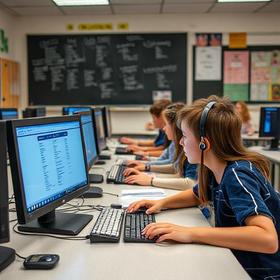Assabet Valley Regional Technical High School is a public vocational high school in the city of Marlborough, Massachusetts, United States.
Serving 1,130 students in grades 9-12, Assabet Valley Vocational High School ranks in the top 50% of all schools in Massachusetts for overall test scores (math proficiency is top 50%, and reading proficiency is top 50%).
The percentage of students achieving proficiency in math is 48% (which is higher than the Massachusetts state average of 42%). The percentage of students achieving proficiency in reading/language arts is 50% (which is higher than the Massachusetts state average of 44%).
The student-teacher ratio of 10:1 is lower than the Massachusetts state level of 12:1.
Minority enrollment is 37% of the student body (majority Hispanic), which is lower than the Massachusetts state average of 47% (majority Hispanic).
Quick Facts (2025-26)
- School Type: Vocational school
- Grades: 9-12
- Enrollment: 1,130 students
- Student-Teacher Ratio: 10:1
- Minority Enrollment: 37%
- Graduation Rate: 97% (Top 10% in MA)
- Overall Testing Rank: Top 50%
- Math Proficiency: 48% (Top 50%)
- Reading Proficiency: 50% (Top 50%)
- Science Proficiency: 43% (Btm 50%)
- Source: National Center for Education Statistics (NCES), MA Dept. of Education
Top Rankings
Assabet Valley Vocational High School ranks among the top 20% of public schools in Massachusetts for:
Category
Attribute
Graduation Rate
Student Attention
School Overview
Assabet Valley Vocational High School's student population of 1,130 students has stayed relatively flat over five school years.
The teacher population of 114 teachers has stayed relatively flat over five school years.
School Type
Grades Offered
Grades 9-12
(Supplemental Virtual)
(Supplemental Virtual)
Total Students
1,130 students
Gender %
Total Classroom Teachers
114 teachers
Year Founded
1973
Colors
Blue, Gold
School Calendar
School Motto
'Education is shaped by society to satisfy certain needs'
School Rankings
Assabet Valley Vocational High School ranks within the top 50% of all 1,626 schools in Massachusetts (based off of combined math and reading proficiency testing data).
The diversity score of Assabet Valley Vocational High School is 0.52, which is less than the diversity score at state average of 0.65. The school's diversity has stayed relatively flat over five school years.
Overall Testing Rank
#665 out of 1626 schools
(Top 50%)
(Top 50%)
Math Test Scores (% Proficient)
48%
42%
Reading/Language Arts Test Scores (% Proficient)
50%
44%
Science Test Scores (% Proficient)
43%
44%
Student-Teacher Ratio
10:1
12:1
American Indian
n/a
n/a
Asian
n/a
7%
Hispanic
30%
25%
Black
3%
10%
White
63%
53%
Hawaiian
n/a
n/a
Two or more races
4%
5%
All Ethnic Groups
Graduation Rate
97%
90%
Participates in the National School Lunch Program (NSLP)
Yes
Eligible for Free Lunch
30%
35%
Eligible for Reduced Lunch
5%
4%
School Statewide Testing
School District Name
Source: National Center for Education Statistics (NCES), MA Dept. of Education
Profile last updated: 02/09/2025
Frequently Asked Questions
What is Assabet Valley Vocational High School's ranking?
Assabet Valley Vocational High School is ranked #665 out of 1,626 schools, which ranks it among the top 50% of public schools in Massachusetts.
What schools are Assabet Valley Vocational High School often compared to?
Assabet Valley Vocational High Schoolis often viewed alongside schools like Blackstone Valley by visitors of our site.
What percent of students have achieved state testing proficiency in math and reading?
48% of students have achieved math proficiency (compared to the 42% MA state average), while 50% of students have achieved reading proficiency (compared to the 44% MA state average).
What is the graduation rate of Assabet Valley Vocational High School?
The graduation rate of Assabet Valley Vocational High School is 97%, which is higher than the Massachusetts state average of 90%.
How many students attend Assabet Valley Vocational High School?
1,130 students attend Assabet Valley Vocational High School.
What is the racial composition of the student body?
63% of Assabet Valley Vocational High School students are White, 30% of students are Hispanic, 4% of students are Two or more races, and 3% of students are Black.
What is the student-teacher ratio of Assabet Valley Vocational High School?
Assabet Valley Vocational High School has a student ration of 10:1, which is lower than the Massachusetts state average of 12:1.
What grades does Assabet Valley Vocational High School offer ?
Assabet Valley Vocational High School offers enrollment in grades 9-12 (Supplemental Virtual).
What school district is Assabet Valley Vocational High School part of?
Assabet Valley Vocational High School is part of Assabet Valley Regional Vocational Technical School District.
School Reviews
5 10/10/2025
my son transferred fromMarlboro High school to Assabet and graduated 5th in his class and got a presidential scholarship to Worcester State College Majoring in Computer Science...What else can I say...They put kids and achievment first..
Review Assabet Valley Vocational High School. Reviews should be a few sentences in length. Please include any comments on:
- Quality of academic programs, teachers, and facilities
- Availability of music, art, sports and other extracurricular activities
Recent Articles

Cybersecurity in U.S. Public Schools 2025: Risks, Policies & Protection
Explore the 2025 state of cybersecurity in U.S. public schools, updated data, expert insights, policy moves, and how schools and families can stay safe.

The Rise of STEM in Public Schools: 2025 Update
Explore how STEM is transforming U.S. public schools in 2025鈥攖rends, policies, programs, and what parents and educators should know.

How Public Schools Support Mental Health in 2025
Explore how U.S. public schools are supporting student mental health in 2025鈥攑rograms, results, challenges and strategies for educators, parents and policymakers.





